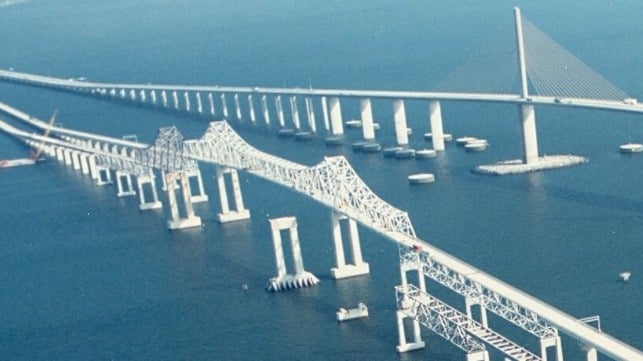Old Safety Lessons May Haunt Baltimore Bridge Tragedy

For observers who have been in shipping long enough, Wednesday's disastrous bridge collapse in Baltimore brought to mind lessons learned in 1980, when the freighter Summit Venture struck and destroyed half of Tampa's Sunshine Skyway bridge. 35 people died in that disaster, prompting a decade-long rethink of highway bridge design. The Skyway Bridge was rebuilt with a fortress of protective concrete dolphins - but it is unclear whether Baltimore's Francis Scott Key Bridge was updated to meet a similar standard before it was hit by the boxship Dali on Wednesday morning.
Baltimore's Key Bridge opened in 1977, three years before the Skyway Bridge disaster (and two years after a similar casualty in Tasmania). Based on visual evidence, the Key Bridge had one small dolphin on each side of the central span's piers, intended either for scour protection or for defending against allisions. When the container ship Dali approached early Wednesday morning, the vessel appeared to pass by the dolphin and strike the pier directly with her starboard bow.
“Maybe [the dolphin] would stop a ferry or something like that,” consulting engineer Donald Dusenberry told the New York Times. “Not a massive, oceangoing cargo ship.”
Tampa-area attorney Steven Yerrid was involved in the response to the Skyway Bridge disaster in 1980, and he told local media that when he saw the fendering system on the Key Bridge, it looked all too familiar. "I felt not only shock, but extreme sadness, because I knew other people had to unnecessarily lose their lives to learn a lesson that was taught 44 years ago," Yarrid told Tampa's Fox 13.
The Skyway Bridge's lessons-learned have been in print for a long time. They were published by NTSB in 1981 and codified by AASHTO, America's highway standards body, in 1991. The new AASHTO rules laid out protection requirements for newly-built bridges and guidance for retrofitting old structures.
Risks still remain, and much depends on implementation of the guidance. In 2002, a barge tow hit a pier on the I-40 bridge in Webbers Falls, Oklahoma, destroying the span and killing 14 people. Only the upstream side of the I-40 bridge had modern structures to protect it from barge traffic - but the casualty vessel approached from the downstream side, which was unprotected.
For many engineers, the fact that a landmark structure like Baltimore's Key Bridge could still be felled by marine traffic in 2024 is a call to action. Recent cases suggest that collapse is not inevitable after a major allision: the 2007 Casco Bay Bridge strike and the Cosco Busan accident both hit modern fendering systems, and the bridges survived.
"As a matter of principle, when there is a bridge pier in a shipping channel we should expect the bridge to be strong enough to withstand impact or to be protected from impact," structural engineer Shankar Nair told the Baltimore Banner.
If the Key Bridge incident ends up in court - as it almost certainly will - the degree of protection around the bridge pier could come up, says José R. Cot, an experienced maritime litigation and insurance attorney at McGlinchey Stafford. Admiralty law presumes that the moving vessel is at fault in an allision, but this can be contested, and the shipowner could argue that the damage would not have been as serious if the pier had had better protection.
"Yes, it could be raised," Cot says. "There has been a historical interest in making fender systems a lot more robust, such that if you have these types of allisions - which are bound to happen - that they do not damage the bridge structure itself. I do think that those representing the vessel interest would probably raise that."

that matters most
Get the latest maritime news delivered to your inbox daily.
Pier protection is among the factors that the NTSB will be examining in the Baltimore accident, and it has requested engineering information and records from the Key Bridge's operator.
Top image: Sunshine Skyway Bridge, 2007 (Apelbaum / CC BY SA 3.0)
